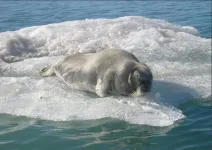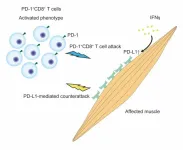(Press-News.org) Arctic seals have evolved many adaptations to cope with their frosty environment—one that you might not immediately think of is the bones in their nasal cavity. Arctic seals have more convoluted nasal passages than seal species that live in milder environments, and researchers report December 14 in the Biophysical Journal that these structures help the seals more efficiently retain heat and moisture as they breathe in and out.
“Thanks to this elaborate structure in their nasal cavities, Arctic seals lose less heat through nasal heat exchange than subtropical seals when both are exposed to the same conditions,” says corresponding author and physical chemist Signe Kjelstrup of the Norwegian University of Science and Technology. “This provides an evolutionary advantage, especially in the Arctic where heat loss is energy dissipation, which must be replenished by food.”
“What’s so amazing is that these Arctic seals retain 94% of the water when they breathe in and out,” says Kjelstrup. “This means that most of the water added to the air during inhalation is then recovered during exhalation.”
In cold, dry environments, animals lose heat and moisture just by breathing. Most mammals and birds have complex bones called maxilloturbinates inside their nasal cavities that help to minimize this risk. These porous, bony shelves are covered with a richly vascularized layer of mucosal tissues that warm and humidify inhaled air, which is important for lung function, and reduce the amount of heat and moisture lost during exhalation.
The structure of these bones varies between species, however. Kjelstrup’s team previously showed that reindeer noses enable efficient heat exchange in cold conditions, but because reindeer don’t live in diverse environments, they turned to seals to test whether there’s anything special about the noses of Arctic animals.
“You can't find reindeer in the middle of the Mediterranean, but seals live in many different environments, so they allowed us to test this question,” says Kjelstrup. “And we knew from a previous study that Arctic seal noses are sponge-like and very dense, whereas the Mediterranean seal nose has a more open structure.”
The researchers used computer tomography to make 3D models of the nasal cavities/maxilloturbinates of an Arctic species of seal, the bearded seal (Erignathus barbatus), and a subtropical species, the Mediterranean monk seal (Monachus monachus). Then, they used energy dissipation models to compare the seals’ ability to warm and moisten air during inhalation and to reduce heat and moisture loss during exhalation. The team tested both seals under Arctic conditions (−30°C), and at 10°C, which would represent a cold day for a Mediterranean monk seal. They also tweaked different parameters within the model to identify geometrical features of the nasal cavity that are important for its function.
The model indicated that Arctic seals are much more efficient than subtropical seals at retaining heat and water exchange in both Arctic and Mediterranean ambient temperatures. At −30°C, the subterranean seals lost 1.45 times as much heat and 3.5 times as much water per breath cycle as the Arctic seals, and at 10°C, the subterranean seals lost 1.5 times as much heat and 1.7 times as much water.
This advantage was due to the Arctic seal’s more complex, dense nasal cavity. Specifically, the researchers showed that the increased perimeter of the Arctic seal’s maxilloturbinates is key to limiting energy dissipation at low ambient temperatures.
The study investigated moisture and heat loss per breath cycle (i.e., for one inhalation and exhalation), but the role of breathing rate remains unclear. This is especially complicated for seals, who pause their breathing for minutes at a time when they dive.
In the future, the researchers hope to study the nasal structures of other species to see if different structures provide evolutionary advantages in other environments. “The camel, for instance, doesn't need to save much on heat, but it does need to save on water, so one may speculate that it could tell us something about relative importance of the two,” says Kjelstrup.
Ultimately, the researchers plan to use this information to engineer more efficient heat exchangers and ventilation systems. “If nature manages to create such great heat exchangers, I think we should copy that in engineering to create more efficient processes, for instance, in air conditioners,” says Kjelstrup.
###
This research was supported by the Research Council of Norway and the Tromsø Research Foundation.
Biophysical Journal, Cheon et al., “Structure-function relationships in the nasal cavity of Arctic and subtropical seals” https://cell.com/biophysical-journal/fulltext/S0006-3495(23)00712-9
Biophysical Journal (@BiophysJ), published by Cell Press for the Biophysical Society, is a bimonthly journal that publishes original research and reviews on the most important developments in modern biophysics—a broad and rapidly advancing field encompassing the study of biological structures and focusing on mechanisms at the molecular, cellular, and systems levels through the concepts and methods of physics, chemistry, mathematics, engineering, and computational science. Visit http://www.cell.com/biophysj/home. To receive Cell Press media alerts, contact press@cell.com.
END
Aging poses a number of challenges to the body’s well-being, one of the most important being an increased susceptibility to multiple diseases, including urinary tract infections (UTIs). The connection between aging and more prevalent UTIs is not well understood, but now researchers at Baylor College of Medicine have found an explanation.
The researchers show in the journal Developmental Cell that, compared to the younger counterpart, the aging urinary tract in animal models changes how it functions at the cellular level in ways that seem to favor the establishment ...
People who live in neighborhoods with higher levels of poverty and unemployment are less likely to fill their heart-failure drug prescriptions than those living in wealthier areas, a new study shows. The findings not only add to understanding geographic and economic disparities in heart disease care, but also point to new ways to address barriers for patients taking these lifesaving drugs.
Led by researchers at NYU Grossman School of Medicine, the study explored prescription pickup patterns among patients with systolic heart failure, a chronic, life-threatening ...
Cats tend to dictate games of fetch with their owners and most cats who play fetch learned to do so without explicit training, according to a survey of 924 cat owners published in Scientific Reports. The findings also highlight the variety of objects that cats prefer to fetch, including hair ties and bottle parts.
Jemma Forman, Elizabeth Renner and David Leavens surveyed cat owners who reported fetching behaviours in 1,154 cats that they currently or previously owned. Owners reported how fetching first occurred, how often it occurs ...
A multidisciplinary study published in Nature has elucidated the structure of the machinery responsible for writing much of our “dark genome” — the 98 percent of our DNA that has largely unknown biological function. These results may spur entirely novel treatments for autoimmune diseases, cancer and neurodegeneration.
An international team of scientists from Rutgers and more than a dozen other institutions, including both academia and industry, have published the first high-resolution images and structural details of avirus-like element known as LINE-1. They describe it as “an ancient genetic parasite” that is one of the most common parts of human DNA (video ...
About The Study: In this study of 6,247 patients with heart failure with reduced ejection fraction, patients living in neighborhoods with lower neighborhood-level socioeconomic status had significantly higher odds of nonadherence to guideline-directed medical therapy. These findings highlight the importance of considering neighborhood-level disparities when developing approaches to improve medication adherence.
Authors: Amrita Mukhopadhyay, M.D., of the NYU Grossman School of Medicine in New York, is the corresponding ...
About The Study: The natural history of sleep disturbances was associated with both resolved and incident emotional and behavioral difficulties in this study of 17,000 preschool-aged children. Routine screening and precise intervention for sleep disturbances may benefit the psychosocial well-being of this population.
Authors: Fan Jiang, M.D., Ph.D., and Guanghai Wang, Ph.D., of Shanghai Jiao Tong University in Shanghai, are the corresponding authors.
To access the embargoed study: Visit our For The Media ...
Immunotherapy in combination with chemotherapy has become an important therapeutic treatment option in some patients with metastatic breast cancer. Which patients will benefit the most, however, remains unclear; current biomarkers such as PD-L1 that are used to predict response are mediocre at best. Vanderbilt researchers led a clinical trial combining atezolizumab, an immunotherapy, in combination with chemotherapy in patients with metastatic triple-negative breast cancer to both evaluate the efficacy of the treatment combination and to understand biomarkers of response ...
Researchers from the Shenzhen Institute of Advanced Technology (SIAT) of the Chinese Academy of Sciences (CAS) and their collaborators have uncovered the coding principle underlying self-centered (egocentric) representation in spatial perception. The study was published in Neuron on Dec. 14.
Our understanding of the intricate spatial perception mechanisms in the human brain has recently advanced with the discovery that self-centered perception of external items is closely integrated with our world-centered understanding of the world, which is the brain's internal "GPS" system. Given ...
Artificial Intelligence (AI) and 3D images of the human tongue have revealed that the surface of our tongues are unique to each of us, new findings suggest.
The results offer an unprecedented insight into the biological make-up of our tongue’s surface and how our sense of taste and touch differ from person to person.
The research has huge potential for discovering individual food preferences, developing healthy food alternatives and early diagnosis of oral cancers in the future, experts say.
The human tongue is a highly sophisticated and ...
Researchers from Tokyo Medical and Dental University (TMDU) identify the T cells that, when activated, are pathogenic in a subset of idiopathic inflammatory myopathies
Tokyo, Japan – Inflammation is an important part of the body’s defenses, eliminating threats and repairing damage. When the immune system is overactivated, though, it can turn from friend to foe. Now, researchers from Japan have identified the culprit responsible for one type of harmful inflammation that occurs in certain muscular disorders.
In a study published last month in the Journal of Autoimmunity, ...

